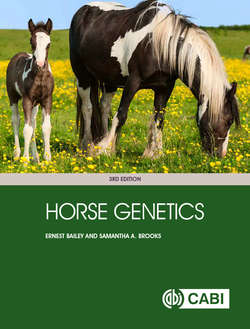Читать книгу Horse Genetics - Ernest Bailey - Страница 16
На сайте Литреса книга снята с продажи.
Climate, environment and evolution
ОглавлениеThe climate in America is profoundly different today than 50 million years ago. Geological records indicate North America had a tropical environment, characterized by marshy ground and lush, woody vegetation. The five toes of hyracotheria allowed it to walk easily through marshlands, its prehensile lips were ideal to browse tender shoots, leaves, and branches. As the climate became drier and marshes gave way to grasslands, species adapted. Characteristics that favored browsers were replaced by characteristics that favored grazers. For example, teeth evolved in response to the challenges of eating grasses in sandy soil (Fig. 2.3). Inclusion of sand and dirt during grazing completely wears down the enamel crowns of teeth. Individuals with higher-crowned teeth, and especially those with teeth that grew throughout life, were better able to eat grasses. They were better fed and had more offspring than equids with their short, crowned teeth. Horse teeth have been well preserved because they are so hard and have been particularly useful in tracking the evolutionary history of Equidae. From the Eocene to the early Miocene periods (58–20 million years ago) horses had short crown teeth (brachyodonts) but were replaced by species adapted to grasslands with high-crowned teeth (hypsodonts) (MacFadden, 2005).
Fig. 2.3. Cheek-tooth crown height in extant and fossil equids. A and B illustrate the appearance low crown (brachydont) and high crown teeth (hypsodont), respectively. C shows their appearance in the fossil record from 60 million years ago to present (reprinted from Janis and Fortelius 1988.)
Climate change triggered ecological consequences which drove the migration of many of these ancestral equid species. A land bridge appeared between North America and Asia, at the location of the modern Bering Strait, between 15 and 20 million years ago and relatives of the horse (Anchiterium and Sinohippus) crossed into Asia. They thrived in Asia, Africa, and Europe for millions of years before they also went extinct everywhere.
Approximately 18 million years ago, extensive grasslands developed in North America. Grazing became advantageous for the equid species that evolved hypsodont teeth for grazing. Furthermore, in the drier, open climates, the ancestors of horses that could travel farther and faster were favored. Adaptations for travel led horses to be more successful in finding food than others. Consequently, those with a single toe, the hoof, and other adaptations for travel had more successful offspring than others. Speed may have also provided protection from fleet predators. Migrations occurred a second and a third time, 5–10 million years ago, as more relatives of the horse (hipparions) crossed the land bridge to Asia and thrived for millions of years before, once again, becoming extinct on the Eurasian continent.
Meanwhile, the ancestors of modern horses continued to evolve in North America with the genus Equus appearing approximately 4–5 million years ago. These early species of Equus also crossed the land bridge to Asia, populating Asia, Africa, and Europe. This time, however, after the bridge closed about 12,000 years ago, Equus became extinct in the Americas while thriving on the Eurasian and African continents. We do not know why all of representatives of Equus became extinct in North America but continued to thrive in Asia, Europe, and Africa. Both climate change and predation by people are suspected. Regardless of the extinction in North America, Equus continued its evolution in Asia, Africa, and Europe, differentiating into the diverse species of horses, asses, Asiatic asses and zebras we have today.
